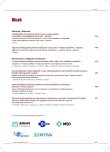Ivabradine in patients with stable ischemic heart disease and left ventricular systolic dysfunction: the results of the BEAUTIFUL study
Authors:
J. Filipovský
Authors‘ workplace:
II. interní klinika Lékařské fakulty UK a FN Plzeň, přednosta prof. MUDr. Jan Filipovský, CSc.
Published in:
Vnitř Lék 2009; 55(5): 513-516
Category:
Reviews
Overview
Ivabradine reduces heart rate by inhibiting the If channels mediated current, while sinus rhythm is sustained. The aim of the BEAUTIFUL study was to assess whether the administration of ivabradine to patients with stable ischemic heart disease and ejection fraction ≤ 40% will result in reduction of cardiovascular morbidity and mortality. This was a double blind randomized study including 10,917 patients. Half of the patients were administered placebo and half were treated with ivabradine additional to the treatment normally used in the secondary prevention of ischemic heart disease; the starting dose was 5 mg twice a day and could be increased to 7.5 mg twice a day. The combined primary endpoint was cardiovascular-event related death, hospitalization for acute myocardial infarction and hospitalization for heart failure. The follow up was 19 months. Ivabradine decreased heart rate by 6 beats/min. The majority of patients took beta‑blockers (87%) and combination with ivabradine was well tolerated. Ivabradine did not significantly affect the combined primary endpoint. Significant reduction by 36% (p = 0.001) in myocardial infarction and by 30% (p = 0.016) in coronary revascularization was observed in the pre‑defined subgroup of patients with heart rate ≥ 70/min. Adverse events rate was the same in the active and the control groups. It is possible to conclude that ivabradine did not improve cardiovascular prognosis in all patients with stable ischemic heart disease and decreased ejection fraction but was beneficial as an additional add-on treatment to the current medication, including beta‑blockers, in patients whose heart rate was ≥ 70/min.
Key words:
ivabradine – heart rate – ischemic heart disease – secondary prevention
Sources
1. Borer JS, Fox K, Jaillon P et al. Antianginal and antiischemic effects of ivabradine, an If inhibitor, in stable angina: a randomized, double-blind, multicentered, placebo-controlled trial. Circulation 2003; 107 : 817–823.
2. Fox K, Ford I, Steg PG et al on behalf of the BEAUTIFUL Investigators. Ivabradine for patients with stable coronary artery disease and left-ventricular systolic dysfunction (BEAUTIFUL): a randomised, double blind, placebo-controlled trial. Lancet 2008; 372 : 807–816.
3. Diaz A, Bourassa MG, Guertin MC et al. Long‑term prognostic value of resting heart rate in patients with suspected or proven coronary artery disease. Eur Heart J 2005; 26 : 967–974.
Labels
Diabetology Endocrinology Internal medicineArticle was published in
Internal Medicine

2009 Issue 5
Most read in this issue
- Extrinsic allergic alveolitis – rarely diagnoticated disease
- Turner’s syndrome requires multidisciplinary approach
- Comparison of various methods of body fat analysis in overweight and obese women
- Turner syndrome is associated with increased cardiovascular morbidity and mortality
